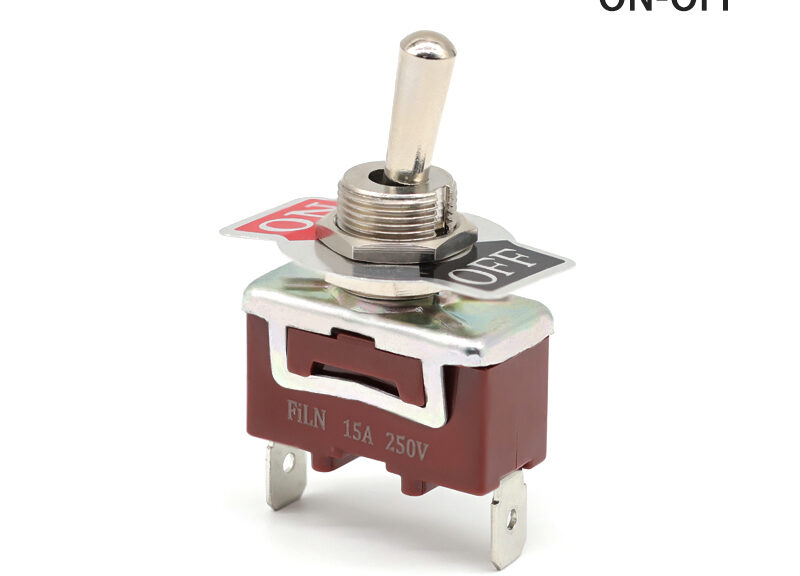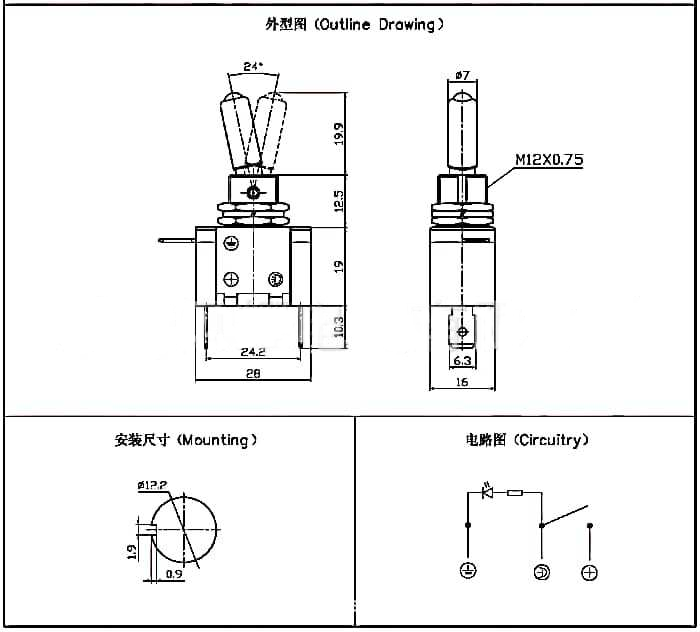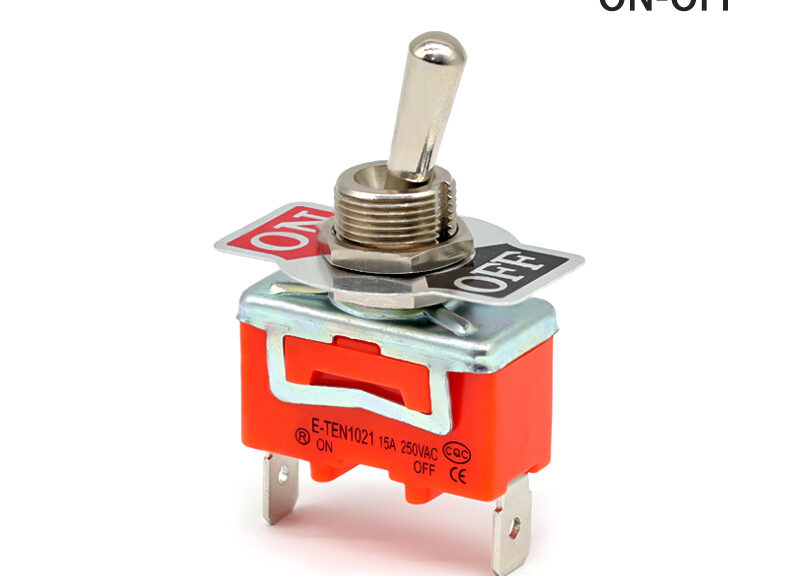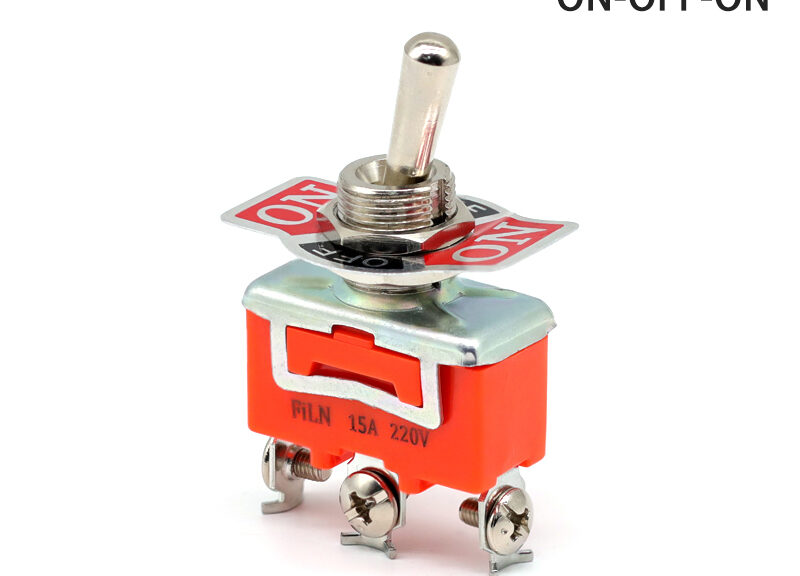Toggle On Off: A Comprehensive Guide to ON/OFF Toggle Button, ON-OFF-ON Toggle Switches, and More
Toggle on off switches are an essential aspect of modern technology, enabling control across various applications. From ON-OFF-ON toggle switches used in households, industries, and vehicles to the HTML toggle switch employed in web development, this versatile technology caters to a wide array of needs. This comprehensive guide explores the different types of toggle switches, their applications, considerations for choosing the right one, and even tips on maintenance and safety. If you are keen to explore the fascinating world of toggle switches and understand how to leverage them effectively, this article is your go-to resource.
Step 1: Most Asked Questions
Below are the 10 most asked questions related to toggle on off:
1. What is a toggle on off switch, and how does it work?
2. How do you wire an on-off-on toggle switch diagram?
3. What are the different types of ON-OFF-ON toggle switches?
4. How to use an HTML toggle switch in web design?
5. What is the difference between an ON/OFF toggle button and an on-off-on toggle switch?
6. How to select the right toggle switch for different applications?
7. What safety considerations should be taken into account when using ON – OFF toggle switches?
8. How to troubleshoot common issues with toggle switch on/off position?
9. Where can one find reliable on off / on toggle switch diagrams and resources?
10. How to maintain and care for your ON – OFF toggle switches?
Step 2: What is a Toggle On Off Switch, and How Does it Work?
Definition of a Toggle On Off Switch:A toggle on off switch is a type of electrical switch that is manually activated by moving a lever, handle, or other mechanisms. It can control the flow of electrical current, turning it either “ON” or “OFF.”
Functioning of a Toggle On Off Switch:Toggle switches work by opening or closing an electrical circuit. The toggle lever’s movement will change the connection between internal contacts, allowing or interrupting the current flow.
Types of Toggle On Off Switch:There are various types of toggle switches, such as ON/OFF toggle button and ON-OFF-ON toggle switches. Each type has specific functionalities and applications.
Common Applications:From household appliances to industrial machinery, toggle switches are used in various domains. They allow users to manually control devices, such as turning lights on and off.
Advantages of Using a Toggle On Off Switch:Toggle switches are known for their durability, simplicity, and reliability. They provide a clear indication of the current state, either ON or OFF.
Connection with Technology:In modern technology, toggle switches are also implemented in software interfaces, such as [HTML toggle switch](https://www.indicatorlight.com/category/toggle-switch/). They enable digital on/off control.
Components of a Toggle On Off Switch:A standard toggle switch consists of a lever, contacts, a housing, and terminals. The lever’s movement actuates the contacts, controlling the flow of current.
The ON-OFF-ON Toggle Switch:A particular variant is the ON-OFF-ON toggle switch, allowing three positions. It can connect to different circuits, giving more control options.
Safety Considerations:When using a toggle switch, it’s vital to follow proper installation procedures and use the switch within its specified ratings to avoid safety hazards.
Buying a Toggle On Off Switch:For buying quality toggle switches, you can visit [Indicator Light](https://www.indicatorlight.com/), where you can find a wide range of switches tailored to your needs.
Step 3: How Do You Wire an Toggle On Off Switch Diagram?
Understanding the Diagram
An Toggle On Off Switch diagram represents the wiring connections of the switch. It guides the installation process and helps in troubleshooting.
Wiring Basics
Wiring an Toggle On Off Switch requires understanding the specific contacts and terminals. Typically, there are three terminals for the three positions.
Tools Required
To wire a Toggle On Off Switch, you’ll need wire strippers, a soldering iron, a screwdriver, and suitable wiring. Ensure the wires are of the correct gauge.
Preparing the Wires
Before wiring, it’s essential to strip the wires’ ends and pre-solder or twist them if necessary. Proper preparation ensures a strong connection.
Connecting the Terminals
Follow the Toggle On Off Switch diagram and connect the wires to the appropriate terminals. Often, the center terminal is common, connecting to the power source.
Testing the Connections
After wiring, test the switch to ensure that it functions correctly in all positions. Verify the connections by visually inspecting and using a multimeter.
Safety Precautions
When wiring a Toggle On Off Switch, always turn off the power to the circuit and follow safety guidelines. Proper insulation and grounding are crucial.
Troubleshooting
If the toggle switch is not functioning correctly, consult the on-off-on toggle switch diagram and check for loose connections, damaged wires, or other issues.
Professional Assistance
In some cases, it might be best to seek professional help if you’re unsure about the wiring process. Electricians have the expertise to handle the task safely.
Additional Resources
For additional wiring resources and toggle switches, you can visit [Indicator Light’s Toggle Switch Category](https://www.indicatorlight.com/category/toggle-switch/), offering valuable information and products.
Step 4: What Are the Different Types of ON-OFF-ON Toggle Switches?
Introduction to ON-OFF-ON Toggle Switches
ON-OFF-ON toggle switches are a specific type of toggle switch that allows three positions. This type of switch can control multiple circuits and offers versatile usage.
SPDT (Single Pole Double Throw) Toggle Switches
SPDT switches have one common terminal and two other terminals that can be connected to it. They can switch between two different circuits, making them highly adaptable.
DPDT (Double Pole Double Throw) Toggle Switches
DPDT switches are like SPDT but with two separate circuits. They can control two circuits simultaneously, offering more complex control options.
Momentary Toggle Switches
Some ON-OFF-ON toggle switches are momentary, meaning they return to the OFF position when released. These are often used in applications where temporary activation is required.
Industrial Grade Toggle Switches
Industrial-grade ON-OFF-ON toggle switches are designed to withstand harsh conditions. They are built with robust materials and used in industrial applications.
Marine Toggle Switches
Marine toggle switches are created specifically for maritime environments. They usually have added protection against moisture and corrosion.
Automotive Toggle Switches
In the automotive industry, ON-OFF-ON toggle switches control various functions within vehicles. They are designed to fit within the automotive electrical system.
Customizable Toggle Switches
Some manufacturers offer customizable ON-OFF-ON toggle switches, where users can select specific features, such as lever type, color, or terminal configuration.
Importance of Choosing the Right Type
Selecting the appropriate type of ON-OFF-ON toggle switch is essential for the application’s success. Understanding the requirements helps in making the right choice.
Where to Buy
Different types of ON-OFF-ON toggle switches can be found at [Indicator Light](https://www.indicatorlight.com/), catering to various industrial, automotive, marine, and other needs.
Step 5: How to Use an HTML Toggle Switch in Web Design?
Introduction to HTML Toggle Switch:An HTML toggle switch is a UI element that allows users to switch between two states, often ON and OFF. It is commonly used in web design to control settings or preferences.
Creating a Basic HTML Toggle Switch:A basic HTML toggle switch can be created using HTML and CSS. The HTML part includes input and label elements, while CSS styles the appearance.
Enhancing with JavaScript:For more interactive behavior, JavaScript can be added to the HTML toggle switch. It allows dynamic changes based on the user’s interaction.
Customizing the Appearance:Designers can fully customize the appearance of an HTML toggle switch. Using CSS, they can change the size, colors, and transitions to fit the website’s theme.
Implementing Accessibility:Accessibility is crucial in web design. Using proper attributes and ARIA roles ensures that the HTML toggle switch is accessible to all users, including those using assistive technologies.
Step 6: What Is the Difference Between an ON/OFF Toggle Button and an On-Off-On Toggle Switch?
Understanding ON/OFF Toggle Button
An ON/OFF toggle button is a simple switch that has two positions, ON and OFF. It can be found in various applications, both in physical devices and digital interfaces.
Understanding On-Off-On Toggle Switch
An on-off-on toggle switch, on the other hand, offers three positions. This allows control over multiple circuits or provides additional functionality.
Physical vs. Digital
While ON/OFF toggle buttons can be physical or digital, the term often refers to digital UI elements. On-off-on toggle switches are typically physical devices.
Applications and Usage
ON/OFF toggle buttons are widely used in software interfaces, while on-off-on toggle switches are common in machinery, automotive, and marine applications.
Design and Aesthetics
In digital design, ON/OFF toggle buttons can be styled according to the user interface’s theme. Physical on-off-on toggle switches may have specific design considerations for their application.
Complexity and Functionality
On-off-on toggle switches tend to be more complex due to the additional position. They can control more circuits and offer more nuanced control.
Integration in Systems
Both types of switches integrate differently into systems. ON/OFF toggle buttons in software require coding, while physical switches need proper wiring and installation.
Maintenance Considerations
Physical on-off-on toggle switches may require periodic maintenance, while digital ON/OFF toggle buttons might need updates to remain compatible with newer software versions.
Selection and Procurement
When selecting either type of switch, understanding the specific needs of the application is key. ON/OFF toggle buttons in digital design may require specific coding skills, whereas on-off-on toggle switches need proper electrical specifications.
Online Resources
For both digital and physical toggle switches, online resources like [Indicator Light](https://www.indicatorlight.com/category/toggle-switch/) provide valuable information and products to suit various needs.
Step 7: How to Create an on-off-on Toggle Switch Diagram?
Introduction to On-off-on Toggle Switch Diagrams
Creating an on-off-on toggle switch diagram is essential for understanding the wiring and functionality of these types of switches. Here’s how to design such a diagram.
Determine the Purpose and Requirements
Identify the specific application and needs for the on-off-on toggle switch. This will guide the selection of the switch type and help in determining the correct wiring.
Choose the Right Tools
There are many software tools available for creating diagrams, such as AutoCAD, Visio, or even simple drawing tools like Microsoft Paint. Choose one that fits your needs and expertise.
Sketch the Basic Layout
Start by sketching the basic layout of the on-off-on toggle switch diagram. Include the switch, terminals, and connections to represent the electrical circuit.
Label the Components
Labeling the components within the diagram ensures clarity. Include the names of parts, wire colors, and any other important information.
Represent the Three Positions
Clearly show the three positions of the on-off-on toggle switch in the diagram. This helps in understanding how the switch functions at different states.
Include Additional Components
If the on-off-on toggle switch is part of a more complex circuit, include other components such as resistors, capacitors, or motors in the diagram.
Add Annotations and Notes
Annotations and notes provide additional context and information about the diagram. This might include the purpose, specifications, or any special instructions.
Review and Verify
Always review and verify the diagram with a knowledgeable person or reference material to ensure that it’s accurate and complies with all relevant standards.
Create Digital or Physical Copies
Depending on the needs, create digital or physical copies of the on-off-on toggle switch diagram. This ensures that it’s readily available for reference or use.
Utilize Online Resources
Online resources, such as [Indicator Light’s Toggle Switch category](https://www.indicatorlight.com/category/toggle-switch/), provide valuable information and tools that can assist in creating a professional diagram.
Step 8: What Are Toggle Switch On/Off Positions and How Do They Work?
Understanding Toggle Switch On/Off Positions:Toggle switch on/off positions refer to the two basic states of a standard toggle switch. Understanding how these positions work is fundamental to many applications.
ON Position:In the ON position, the toggle switch completes the circuit, allowing current to flow. This position activates the connected device or system.
OFF Position:In the OFF position, the toggle switch breaks the circuit, stopping the flow of current. This position deactivates the connected device or system.
Mechanical Functioning:Mechanically, the toggle switch moves between ON and OFF positions by pivoting around a hinge. This movement opens or closes the internal contacts.
Electrical Considerations:From an electrical perspective, the on/off positions of a toggle switch must be rated for the specific voltage and current they will handle. Misuse can lead to failure or safety hazards.
Applications of Toggle Switch On/Off Positions:Toggle switch on/off positions are used in countless applications, from household light switches to industrial machinery controls.
User Interface and Design:The design of the toggle switch must consider user interaction. Labels, colors, and shapes help users understand and operate the switch correctly.
Safety and Regulations:Compliance with safety standards and regulations is essential when designing and using toggle switch on/off positions, especially in critical or high-power applications.
Selection and Procurement:Choosing the right toggle switch requires understanding the application’s needs, including electrical specifications, environmental conditions, and user interface requirements.
Maintenance and Troubleshooting:Regular maintenance and troubleshooting are vital for the long-term reliability of toggle switch on/off positions. Proper care ensures that they function as intended.
Learning and Resources:For further information on toggle switches, including various on/off positions, you can refer to resources like [Indicator Light](https://www.indicatorlight.com/).
Step 9: How to Connect a Toggle Switch On/Off Position in a Circuit?
Introduction to Connecting a Toggle Switch
Connecting a toggle switch on/off position in a circuit is a common task in electrical wiring. Proper connection ensures the switch operates correctly and safely.
Determine the Switch Type
Identify the type of toggle switch suitable for the application. This includes considering factors like voltage rating, current capacity, and the number of poles and throws.
Understand the Wiring Diagram
A wiring diagram will guide the connection process. It shows how the toggle switch integrates with other components in the circuit.
Gather Necessary Tools and Materials
Tools like wire strippers, screwdrivers, and materials such as wires and connectors are essential for connecting the toggle switch.
Turn Off Power
Always turn off the power to the circuit before working on it. This ensures safety while connecting the toggle switch.
Connect the Wires
Follow the wiring diagram to connect the wires to the toggle switch. The specific connections will depend on the switch type and the circuit’s needs.
Secure the Connections
Ensure that all connections are secure. Loose connections can cause malfunctions and may even be a fire hazard.
Mount the Toggle Switch
Mount the toggle switch in the desired location, whether it’s a panel, wall, or device. Proper mounting ensures ease of use and stability.
Test the Circuit
After connecting the toggle switch, test the circuit to make sure it functions correctly. Any issues should be addressed immediately.
Follow Safety Guidelines
Always follow safety guidelines and local regulations when connecting a toggle switch. Proper practices ensure the safety of both the user and the system.
Seek Professional Help if Needed
If you are unsure about connecting a toggle switch, seeking professional help is wise. Electrical professionals have the knowledge and experience to ensure proper installation.
Learn from Online Resources
Online resources like [Indicator Light’s Toggle Switch category](https://www.indicatorlight.com/category/toggle-switch/) offer guides and products to assist in connecting toggle switches correctly.
Step 10: How to Use ON-OFF-ON Toggle Switches in Different Applications?
Introduction to ON-OFF-ON Toggle Switches
ON-OFF-ON toggle switches are versatile components used to control various devices by allowing three distinct positions. Understanding their functionality opens doors to numerous applications.
Basic Concept of ON-OFF-ON Toggle Switches
An ON-OFF-ON toggle switch can switch between two separate circuits, turning them ON or OFF, with a neutral middle position. It provides more control and flexibility.
Household Applications
In a household context, these switches may control two different light sources or fans, allowing the user to select between them while having an OFF position.
Industrial Applications
In industrial settings, ON-OFF-ON toggle switches can control different machinery parts, toggle between various operation modes, or serve as safety switches.
Automotive Applications
In vehicles, these switches may control multiple functionalities like interior lighting, wipers, or vent fans, offering the driver convenient control.
Electronic Devices
In electronics, ON-OFF-ON toggle switches are often used to select between different modes or functions, like in sound systems or computer peripherals.
Marine Applications
ON-OFF-ON toggle switches are widely used in boats and ships to control navigation lights, pumps, and other equipment, often tailored for water resistance.
Customizable Features
These switches can be customized with different colors, labels, or shapes for intuitive use, depending on the specific application.
Safety Considerations
Appropriate rating, compliance with regulations, and proper wiring are crucial to ensure safety, especially in high-power or critical applications.
Maintenance and Longevity
Regular inspection, cleaning, and proper usage contribute to the longevity and reliability of ON-OFF-ON toggle switches in any application.
Educational Resources
Online platforms, such as [Indicator Light](https://www.indicatorlight.com/category/toggle-switch/), offer valuable insights and products related to ON-OFF-ON toggle switches.

Step 11: How to Choose the Right HTML Toggle Switch for Your Web Application?
Introduction to HTML Toggle Switches
HTML toggle switches provide a user-friendly interface for web applications, allowing users to toggle between two states. Here’s how to choose the right one for your needs.
Understand the User Requirements
Identify the functionality and aesthetics that the HTML toggle switch must provide. Understanding user needs is the first step in selecting the right switch.
Consider Compatibility
Ensure the HTML toggle switch is compatible with various browsers and devices. This ensures a consistent user experience across different platforms.
Examine Pre-built Solutions
There are many pre-built HTML toggle switch libraries and frameworks available. Examining these can save time and provide professional-quality results.
Customize Appearance
HTML toggle switches can be customized to match the web application’s design and branding. Consider aspects like color, size, and animation.
Ensure Accessibility
Accessibility is crucial in web design. Ensure the HTML toggle switch is accessible to users with disabilities by following the relevant guidelines.
Conclusion
This comprehensive guide on toggle on off, ON-OFF-ON toggle switches, and related concepts covers various aspects and applications. By considering different perspectives, including household, industrial, automotive, marine, electronic, web development, and safety, the reader gains a well-rounded understanding of this essential technology. Always adhering to safety guidelines, selecting the right components, and utilizing available resources such as [Indicator Light](https://www.indicatorlight.com/) ensures successful implementation and operation.










